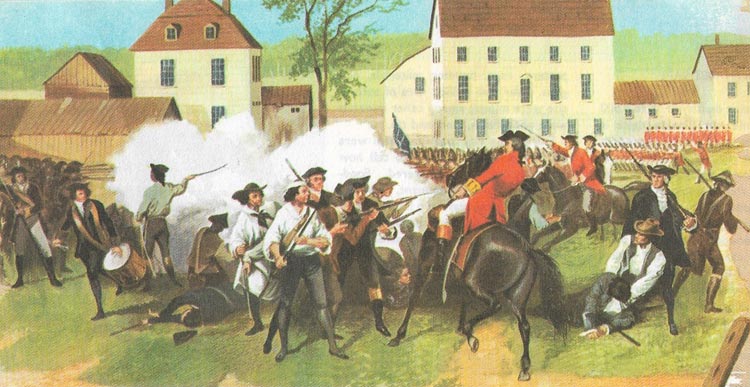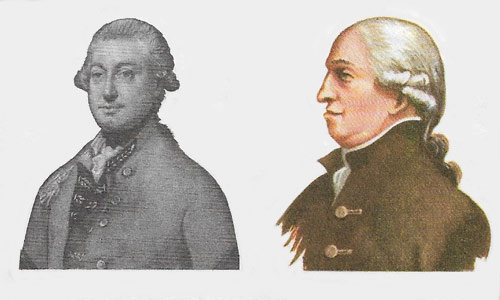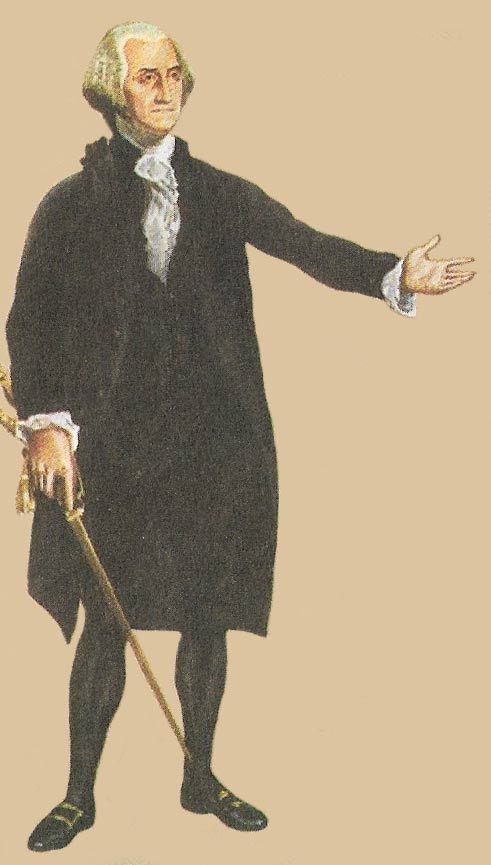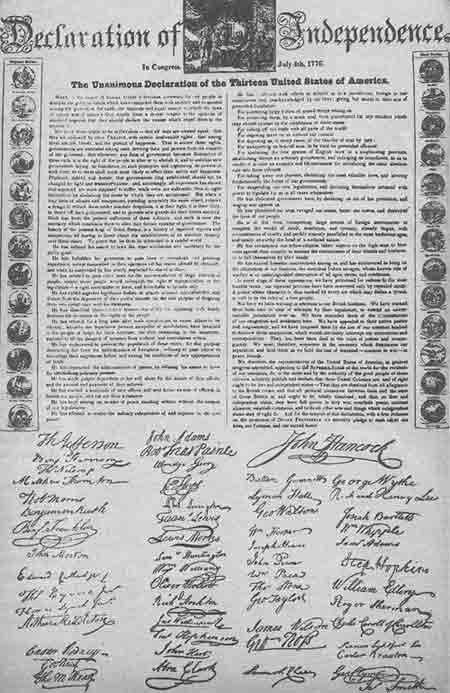American War of Independence

Figure 1. A sudden conflict that led to the Independence of the United States – the battle of Lexington.

Figure 2. Lord Cornwallis (left) and General Burgoyne.

Figure 3. George Washington, first President of the United States.

Figure 4. Declaration of Independence.
It is not easy to grasp the extent of America's progress since the 18th century. British people look back to the time of George III (1760–1820) as part of their modern history. But in this period little of the North American continent was settled, and the thirteen settlements clustered around the Atlantic seaboard were colonies of Great Britain. How these colonies fought and defeated their British rulers is one of the most important episodes of history, for it marked the birth of a nation which was, in only a few generations, to become the most powerful country on Earth.
There was fault on both sides in the succession of disputes which divided Britain and her American colonies in the 18th century. The British attitude – that the colonies should contribute toward their own expenses on such things like defence – was countered by the American stand of 'no taxation without representation' in the British Parliament. But no compromise could be negotiated, and Anglo-American relations deteriorated rapidly. The British continually looked for ways of raising revenue in America by stamp duties, custom duties, and so on. These infuriated the colonists and when, in 1773, the British granted concession on tea to the East India Company at the expense of the American traders, the Americans flung the Company's tea into Boston Harbor. The British took reprisals over the 'Boston Tea Party', and punitive measures were taken against Boston and Massachusetts. Support for Massachusetts grew in the other colonies. A Continental Congress was called in which the Americans agreed to stand together over questions of fundamental rights and to set a blockade against British goods. The American action angered the British, who determined to enforce their authority. In April 1775 General Gage sent a force towards Concord to seize certain military supplies. They were met at Lexington by a small band of American militiamen. A shot was fired, though by who remains a mystery, and a general conflict began (Figure 1). It was only after great difficulty and the loss of 273 men that the British returned to Boston. Armed hostilities had begun, and the Continental Congress, which met in May, had to prepare for the possibility of a full-scale war. George Washington (Figure 3), a soldier of skill and experience, was appointed commander of the American forces in Massachusetts.
The British reaction was swift. George III denounced the insurgents as 'rebels' and ordered the British garrisons and American 'Loyalists' to crush them. In June 1775 Washington's men were defeated after a brave stand at Bunker Hill, but the American commander then besieged Boston with such effect that in March 1776 the British, now under the command of Lord Howe, evacuated the town and retired to Halifax.
Howe's retreat was not the first American success of the war. Late in 1775 the Americans had seized Ticonderoga and Crown Point and had invaded Canada, capturing Montreal. But failed to take Quebec and so also failed to bring Canada on their side against the British.
The American war effort
With the war now underway many problems faced the Americans. They had no regular standing army nor any tradition of cohesive action. The army was composed of volunteers and militiamen, many of who insisted on returning home once the terms of their short service were over. Many delegates at the Continental Congress, which supervised the war effort, were afraid that a standing army would endanger civil liberty, and it was not until the later stages of the war that George Washington managed to obtain a large permanent army. Besides organizing military operations, the colonies, all with differing aims and traditions, had to work together to establish effective systems of local government and economic policy. The war crippled American trade, and consequently home manufacturers had to develop rapidly. They did so, and by the end of the war tremendous progress had been made in the establishment of basic industries necessary for an independent nation's well-being. The desire for independence grew out of the war rather than the other way round. At first there were few Independents, but once the colonies set about ordering their own affairs in a common front against the British a longing for independence, coupled with unity with the other colonies, was forged. On 10 January 1776 Thomas Paine's Common Sense proclaimed: "Now is the seed time of Continental union, faith, and honour."
Everywhere British control was visibly disintegrating and British officials and military commanders were fleeing from the rebels. The colonies began to set up independent governments of their own, and at last, on 2 July 1776, the Congress approved a resolution in favor of independence. Their decision was enshrined in the momentous Declaration of Independence of 4th July (Figure 4), proclaiming that all men were born equal and created with certain rights which no government could take away. The government's duty was to protect those rights: if it failed it was the right of the people to alter or abolish it. The Americans had declared more than their independence: they had proclaimed a philosophy of government and of human rights. But to carry their doctrines into effect they had to defeat Great Britain, and for a time their prospects looked grim. In August 1776 Washington's troops failed in an attempt to capture New York, and though he won a victory at Trenton at Christmas and another at Princeton early in January, he was defeated at Brandywine, lost Philadelphia, and only narrowly escaped disaster at Germantown later in the year. Indeed, as Washington was forced westward to Valley Forge he seemed at the end of his resources. But about this time he was joined by the great German soldier Baron von Steuben, one of the foreign soldiers (like France's Lafayette and Poland's Pulaski) who did much for the American cause. Steuben's arrival encouraged the Americans, and in October came the news of the great American victory at Saratoga which proved one of the decisive battles of history. General Burgoyne had led a major British expedition into northern New York in expectation of being joined by Loyalists. But he was surrounded by American forces and cut off. Reinforcements did not arrive, and on17 October 1777 he surrendered. The British disaster not only cheered the Americans; it also decided France to ally with America. Spain and Holland later joined the anti-British coalition, and the scene was set for the final rout of the British.
Defeat of the British
Despite Saratoga and the intervention of France, the war was far from over. Though the British evacuated Philadelphia in June 1778, they defeated the Americans soon after at the battle of Monmouth and then began a major campaign in the south. They captured Savannah and in time overran most of Georgia, South Carolina, and North Carolina. In May 1780 Charleston fell, and, led by Lord Cornwallis (Figure 2), the British destroyed the American lines at Guilford Courtroom in March 1781. Cornwallis then invaded Virginia before taking the decision to retire to Yorktown in expectation of receiving reinforcements by sea. Though his southern campaigns were successful, Cornwallis had often been hard-pressed. The American forces showed an amazing capacity to reassemble after defeat, and it was in part the perpetual guerrilla attacks that had prompted Cornwallis to retire to Yorktown. Meanwhile, in the west, the Americans had progressed against the British in Illinois and captured the British garrison at Vincennes.
By the summer of 1781 the war had been going on for over five years with no prospect of conclusion. But Cornwallis's decision to enter Yorktown proved a major blunder. Washington saw his chance, and American and French troops were rushed to the south to confine Cornwallis from the landward side. A French fleet kept the British navy at bay and prevented the troops escaping by sea. Cornwallis was trapped, and on the 19 October 1781 he surrendered. The Yorktown surrender proved to be the end of the war. The British were stunned and had no wish to prolong the fight. The peace negotiations were protracted, but eventually peace was signed on 3 September 1783. George III recognized the independence of the United States, and so a new nation appeared in world politics. In founding a government based on the democratic principle of the Declaration of Independence the American people had established a precedent that was to have consequences reaching far into the future.
